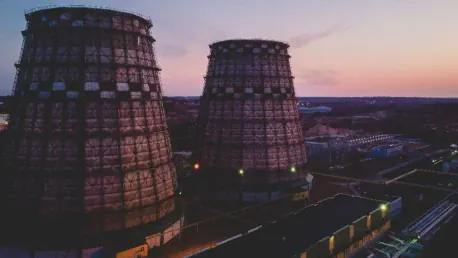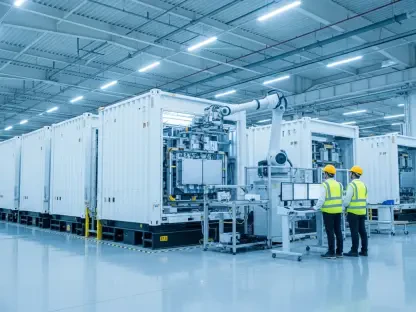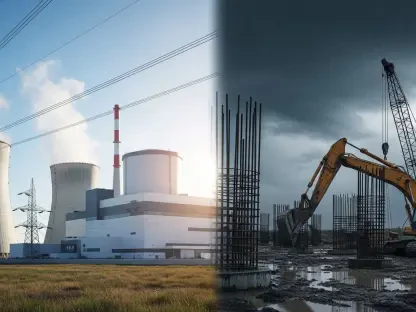Ohio has recently made a significant legislative move by redefining nuclear power as green energy. This development, encapsulated in House Bill 308, signed into law by Governor Mike DeWine on December 19, 2022, has sparked a heated debate among various stakeholders, including environmental advocates, legislators, and organizations, all vying to voice their opinions about the bill’s intent and potential repercussions for the state’s energy future.
Legislative Intent and Purpose
Attracting Jobs and Federal Funding
House Bill 308 is presented by its sponsors, State Representatives Sean Brennan (D-Parma) and Dick Stein (R-Norwalk), as a strategic move designed to attract jobs and federal funding. They argue that by positioning Ohio as a state supportive of nuclear energy, it can become a hub for nuclear power research and development. Stein highlights that this bill sets Ohio apart from other states that oppose nuclear energy, following the establishment of a state nuclear development authority the previous year. The sponsors believe that this could boost not only the local economy but also Ohio’s standing in the rapidly evolving energy sector.
By fostering an environment supportive of nuclear power technology, proponents of House Bill 308 contend that Ohio could gain a competitive edge. This legislative effort is expected to bring considerable financial resources into the state, potentially creating numerous opportunities in the high-tech energy sector. Furthermore, the bill’s passage is seen as a significant step toward addressing the challenges posed by climate change. By welcoming nuclear power, which has a lower carbon footprint compared to fossil fuels, Ohio aims to contribute positively to national and global efforts to reduce greenhouse gas emissions.
Contrast with Other States
The bill’s sponsors emphasize that Ohio’s proactive stance on nuclear energy contrasts sharply with the opposition seen in other states. This legislative move is intended to signal Ohio’s openness to nuclear power, potentially drawing in investments and positioning the state as a leader in the energy sector. The broader context of similar legislative efforts concerning natural gas and nuclear power further underscores this strategic positioning. By differentiating itself from states that resist nuclear energy, Ohio positions itself as a forward-thinking region ready to tackle future energy challenges head-on.
The contrast between Ohio’s approach and that of other states is further highlighted by the potential influx of investments. States opposed to nuclear energy could lose out on federal funding and private investments, while Ohio stands to attract these resources by showcasing its supportive stance. This strategic move is not just about development; it also sends a political message about Ohio’s role in the national energy discourse. As debates around renewable energy intensify, Ohio’s willingness to include nuclear power in its green energy portfolio signals a comprehensive approach to its energy policy.
Criticism and Concerns
Environmental Advocates’ Skepticism
Critics of House Bill 308, particularly environmental advocates, view the reclassification of nuclear power as green energy with skepticism. They argue that this could be a form of greenwashing, diverting public funds away from genuinely renewable energy projects like wind and solar. Megan Hunter, an attorney from Earthjustice, and Nathan Alley, a conservation manager from the Sierra Club of Ohio, are vocal about the potential misuse of this redefinition. They assert that reclassifying nuclear energy as green could undermine efforts to promote truly renewable resources, thereby affecting long-term sustainability goals.
Concerns from environmental advocates also focus on the possible shift in public perception and policy priorities. By labeling nuclear power as green, there is a fear that legislative efforts will gravitate more towards maintaining and developing nuclear facilities rather than investing in newer renewable technologies. This skepticism stems from the long-standing debate about the environmental impact and safety of nuclear energy, which, despite its low carbon emissions, brings up issues related to radioactive waste, potential accidents, and high operational costs. These factors make the debate around House Bill 308 all the more contentious.
Potential Misuse and Future Implications
Environmental advocates express concern that the reclassification could water down future clean energy policies. They fear that companies might obscure their contributions to climate goals by including nuclear and gas as clean energy sources. This could lead to a misallocation of public resources, driving funds away from wind, solar, and other renewable projects. The potential long-term consequences of such a shift raise red flags for advocates who emphasize the importance of genuinely renewable energy in achieving environmental sustainability.
Furthermore, the broadening definition of green energy could lead to loopholes in future legislation. The vagueness around what qualifies as green energy might allow companies to capitalize on government incentives meant solely for renewable energy projects. This potential for exploitation is a critical concern for environmental groups, who worry that it could hamper genuine progress towards reducing carbon emissions. If companies prioritize nuclear and natural gas developments under the guise of green energy, Ohio could witness a stagnation in renewable energy advancements, countering the bill’s purported goal of fostering a sustainable energy future.
Broader Legislative Trends
Redefining Energy Categories
The trend of redefining energy categories is not unique to Ohio. Lawmakers and interest groups across the country are pushing for broader definitions that include non-renewable sources like natural gas and nuclear energy under green or clean energy categories. The American Legislative Exchange Council (ALEC) has been promoting model legislation that supports these redefinitions, contributing to the broader legislative efforts. ALEC’s involvement signifies a concerted effort to reshape the clean energy narrative by incorporating traditional energy sources.
This national trend underscores a shifting landscape in energy policy, where the definitions and classifications of energy types are becoming increasingly fluid. By redefining what qualifies as green energy, states can potentially recalibrate their energy strategies to include a wider range of sources. Such legislative moves may attract investments and facilitate technological advancements in underutilized sectors like nuclear energy. However, this trend also highlights the tension between innovative, yet controversial, energy strategies and the goals of environmental sustainability and integrity.
Legal Challenges and Precedents
Ohio’s 2022 House Bill 507, which classified natural gas as green energy, is currently being challenged in court by a coalition of environmental groups. The lawsuit argues that the bill’s passage violated the Ohio Constitution due to last-minute amendments unrelated to the bill’s original subject. This precedent adds another layer of complexity and concern among critics of House Bill 308, who fear similar legislative tactics may be employed. The legal challenges surrounding House Bill 507 exemplify the contentious processes that often accompany significant changes in energy policy.
This precedent raises questions about legislative transparency and integrity. Critics argue that last-minute amendments compromise the legislative process, allowing for potentially opportunistic inclusions that might not withstand public scrutiny. The ongoing legal battle over House Bill 507 provides a cautionary tale for House Bill 308, as opponents prepare to leverage similar arguments should the need arise. This judicial scrutiny underscores the vital importance of fair legislative practices and the consequences of deviating from established protocols.
Legislative Amendments and Transparency
Last-Minute Amendments
House Bill 308’s last-minute amendments have drawn significant criticism. One such amendment extends the lease terms for drilling under state park and wildlife areas from three years to five years, a provision that Rep. Brennan opposed. This legislative strategy mirrors the contentious process observed with House Bill 507, highlighting ongoing issues with legislative transparency and procedure. Such tactics raise concerns about the fairness and thoroughness of the legislative process, as sudden changes may escape adequate evaluation and debate.
The inclusion of provisions unrelated to the bill’s original scope often leads to legislative ambiguity and potential legal challenges. Critics contend that these last-minute changes undermine the democratic process by bypassing thorough review and stakeholder input. This lack of transparency can result in policy decisions that may not align with public interest or sustainable energy goals. The controversies stemming from these practices suggest a need for more stringent legislative protocols to ensure the integrity and efficacy of the law-making process.
Impact on Future State Programs
While House Bill 308 does not explicitly promise incentives or direct funding shifts, critics warn about its future implications. They fear that future state programs might provide funding advantages to projects that align with the state’s broadened definition of green energy, potentially undermining investments in genuinely renewable energy sources. This concern is rooted in the possibility that favoring nuclear projects could detract from the development of wind, solar, and other sustainable energy initiatives.
The potential for such a shift in funding priorities highlights the need for careful monitoring of future state programs and legislative actions. Ensuring that public resources are allocated effectively and equitably remains a key concern for environmental advocates. The broadened definition of green energy could necessitate new frameworks for evaluating and supporting energy projects. This evolving landscape makes it essential for stakeholders to continue advocating for policies that prioritize genuinely renewable energy sources to foster long-term sustainability.
Supporters’ Perspective
Necessity of Nuclear Power
Despite the criticisms, supporters of House Bill 308 argue for the necessity of nuclear power in the broader energy mix. They contend that renewable sources like wind and solar may not suffice to meet growing energy demands and the transition away from fossil fuels. Rep. Brennan envisions nuclear power playing a crucial role in achieving energy independence and possibly turning Ohio into an electricity exporter. Proponents of the bill emphasize the stability and reliability of nuclear energy as critical components in a diversified energy portfolio.
Supporters point out that technological advancements in nuclear power, such as small modular reactors (SMRs), promise safer and more efficient energy production. These innovations aim to address some of the traditional concerns associated with nuclear power, including waste management and safety risks. By integrating nuclear energy into the green energy definition, Ohio potentially stands to benefit from cutting-edge research and development in this field. This alignment with nuclear power could ensure a more resilient and reliable energy grid in the face of growing demand and climatic uncertainties.
Balancing Energy Needs
Ohio has taken a notable legislative step by categorizing nuclear power as green energy. This significant change, part of House Bill 308, was signed into law by Governor Mike DeWine on December 19, 2022. The decision has ignited a fervent debate among a wide array of stakeholders, including environmental advocates, lawmakers, and various organizations. Each group is eager to share its perspectives on the bill’s goals and its possible effects on Ohio’s energy landscape.
Proponents of the bill argue that nuclear power is a clean and efficient energy source, contributing to reduced carbon emissions and helping to combat climate change. They claim that this redefinition is necessary to meet future energy demands and promote energy independence. On the other hand, critics worry about the potential environmental risks associated with nuclear energy, such as radioactive waste disposal and the high costs of plant maintenance and safety measures. The bill’s long-term impacts on Ohio’s economy and environment remain a contentious point, with both sides continuing to voice strong opinions on this critical issue.









